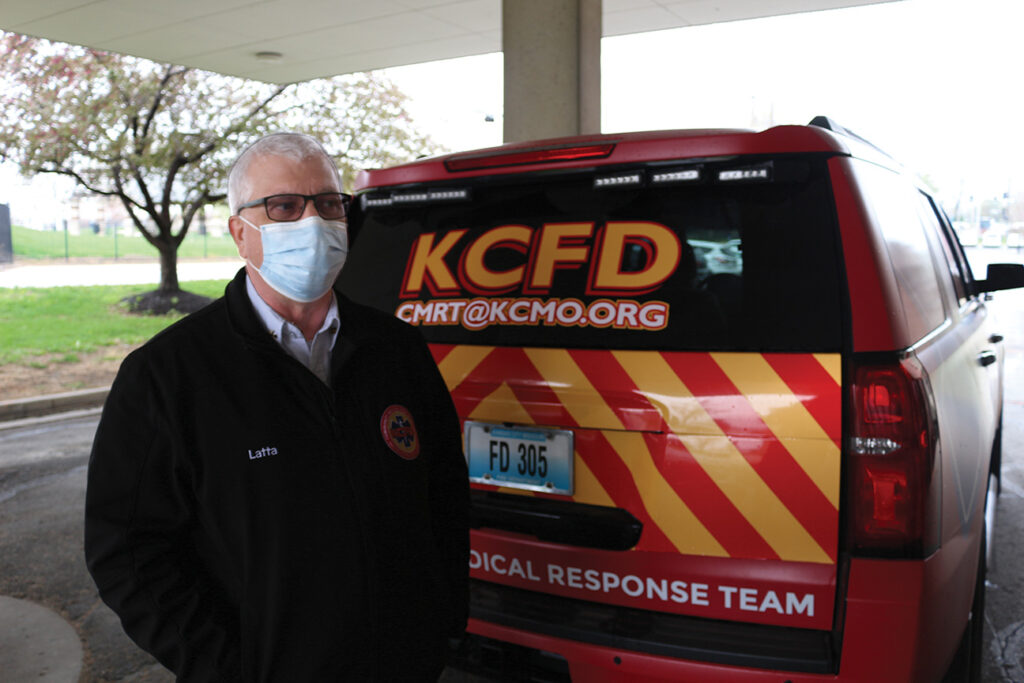
Abby Hoover
Managing Editor
The Kansas City, Mo. Fire Department (KCFD) is working to improve quality of life for residents while also reducing costs with its new Community Medical Response Team (CMRT).
Nearly 80% of all calls to the department involve a request for medical service, and many are from residents with limited access to health care who need help, but not necessarily an ambulance, according to the department.
“We have identified more than 100 residents who call us for service multiple times each year because they have nowhere else to turn,” Fire Chief Donna Lake said. “While each call for service costs around $2,000, it’s really about advocating for people and connecting them to long-term solutions. As good stewards of taxpayer dollars, yes, we want to reduce costs, but more importantly, it’s about improving the quality of life for these residents.”
The CMRT focuses on being both providers and advocates for those whose access to health care is limited by finances, transportation, mobility issues, or the lack of a stable address.
“We have people that call a lot because they just don’t have any other way to get medical care,” CMRT Division Chief Michael Latta said. “We try to go into their house, we try to help them find a primary care doctor, we try and get them home care, and they call us a lot less.”
Latta said a lot of the issues stem from patients being elderly and just needing help around the house. Many of them are homebound aside from medical appointments. The CMRTs relay information about living conditions to their primary care physicians.
“They just don’t know where to go, and a lot of times without a physician coming into their home, they don’t normally get to see how they interact at home, or they think that there’s someone living with them, helping care for them, and there’s not,” Latta said.
They get referred to patients from one of the city’s fire companies if they’re seeing an individual a lot. The CMRTs make contact with the individuals and conduct a visit if they’re willing to accept help.
“Then we do a very deep medical assessment, a fall risk assessment of their house, and then see what services we can help them find or that they need,” Latta said, adding that feedback on the program has been overwhelmingly positive.
Right now they have a list of about 30 clients that they’re assisting, but their call volume depends on referrals.
“We had a gentleman, legally blind, living in an apartment building that was not safe for him, not ADA (Americans with Disabilities Act) compliant whatsoever, and he would have to go out three times a week to dialysis,” Latta explained. “He was having to walk up a flight of stairs, across the little landing and down another flight of stairs to get out of this building.”
The CMRTs helped secure him an ADA compliant building to live in, and he even lives on the first floor now. He can let somebody into the building from his apartment without ever going outside.
“We would go into these houses, and we would see these people, and we knew they needed help, or we would see them multiple times a day sometimes, and we knew taking them to the emergency room wasn’t the answer,” Latta said. “Now we can go and spend time in their house and really help them solve the problems.”
The team of three, which officially got to work last June at the height of the pandemic, is now working to bring COVID-19 vaccines to homebound Kansas Citians. Latta and the two other paramedics have over 30 years of experience each. In this expanded role, these experienced paramedics can take the time to provide healthcare and preventive services to underserved populations in the community.
“Once the personnel were selected, they received training and certification at the state level as Community Paramedics, including completing several clinical hours,” said Chief Lake.
The CMRT has three custom wrapped vehicles to respond to calls. Latta said they have all the supplies to stabilize an individual until an ambulance arrives, if necessary. They are equipped with all the supplies a regular ambulance has, including a cardiac monitor, and portable refrigerators to carry a supply of COVID-19 vaccines.
“People who come to their house, younger people, children, may have it and show no symptoms whatsoever,” Latta said. “The older person could get COVID and die from it. We’ve lost three in our department. We don’t want to lose any more. We want to help everybody get vaccinated, and if it helps the homebound be able to have relatives they haven’t seen in over a year come into their house, how great is that?”
Lake has wanted to implement a program like this for years, even when she left KCFD to work in the City Manager’s office. One of her primary functions there was to coordinate with the medical director, fire and police departments, municipal court, and outside partners like Truman Medical Center and social service groups on what they call “high utilizers” of the public safety system.
“What we find is that in our department, we have people that are using EMS more and more for primary health care, and they either don’t have health insurance, are underrepresented populations, they may or may not be on Medicare or Medicaid,” Lake said.
This innovative program brings KCFD from providing short-term fixes to collaborating on permanent solutions.
“We’re a first response agency, so we’re very reactionary and having enough people on the streets to make all of these calls is important,” Lake said.
With crews working shifts out of their regular stations, they get on a first name basis with high utilizers, and it’s disheartening for first responders to be called to the same situation repeatedly, knowing they’re not getting the help they really need, Latta said, adding that he hopes this will bring a boost to morale.
“If we could partner with an agency that could fix that issue, it would alleviate that from our field crews from having to run those calls over and over again because at the end of the day we’re about public service and our crews want to help people,” Lake said. “It’s frustrating when you know what they need, but we don’t necessarily – in the fire service – don’t have the resources to cause a permanent solution for that person.”
Lake partnered KCFD with Locals 42 and 3808, the firefighters’ unions, on the concept. They’ve been working on quietly building relationships in the community through Mid-American Regional Council (MARC) and others since last summer. The community paramedics are also working to build trust with the field crews as a resource for them.
“What we’re seeing now is we’re connecting up with the social workers in the hospital,” Latta said. “We’ll call a social worker at Truman or St. Luke’s, North Kansas City or one of the other hospitals and say, ‘Hey, we’ve got this individual, they just got brought into the emergency room. Let me explain their living conditions. Can you help us help them get better?’”
When someone calls 9-1-1 and it’s not a law enforcement issue, EMS or firefighters respond, even though it may not be a fire or medical emergency. Each ambulance call costs around $1,500 to $1,700, Lake estimated. For many ambulance calls, a fire truck responds alongside an ambulance to assist.
“Any time those two are tied up, it can be anywhere from 30 minutes to an hour or longer,” Latta said. “Any resources that we save, put them back on the street, they’re there for that next call. It may be more serious, it may be a fire, but they’re available.”
Lake said they’re actively trying to grow the program within the department, but for now the community paramedics are working 9 to 5 schedules. While they’ve faced budget cuts due to the pandemic like other City departments, KCFD is working on improving efficiency. They’re always hiring paramedics and Lake is looking forward to the upcoming academy class graduating.
“It’s really about those individuals, our individual residents that finally find the right resource and the right person that advocates for them and then gets them to a case manager or other solution that helps them navigate the system and solve their issue long term,” Lake said. “That’s the big win for each individual that we touch through our community paramedic program.”
Similar programs are growing across the country as a way to extend healthcare to people in their homes. Latta thinks there will be a growth in these programs in other cities’ fire departments over the next few years because they know there is a need.
Meeting people where they are, whether in their homes or on the street, the CMRT is seeking long-term solutions. Sometimes that’s reconnecting veterans with the VA hospital and services, reStart and reDiscover, or mental health services.
“The homeless population, a lot of them have substance abuse or mental health issues,” Latta said. “It’s hard to get to them and get them the help they need, so another part of our job is like on Monday, I was out with what they call the Homeless Outreach Team. We walked to a bunch of homeless camps and visited with them at their camps.”
Latta said the work the CMRT does has saved at least 300 calls from the last year alone because they’ve helped high utilizers into situations where they don’t need to call as often anymore.
“We’re working with a couple more right now to cut down on those numbers,” Latta said. “But we find the older neighborhoods, the people that have lived there all their life, they don’t want to go anywhere but live in their house. They’re a little afraid to call in, and let somebody come in and help. That’s where we try to make that connection.”
Community paramedics can be reached at cmrt@kcmo.org or (816) 513-4603.

















